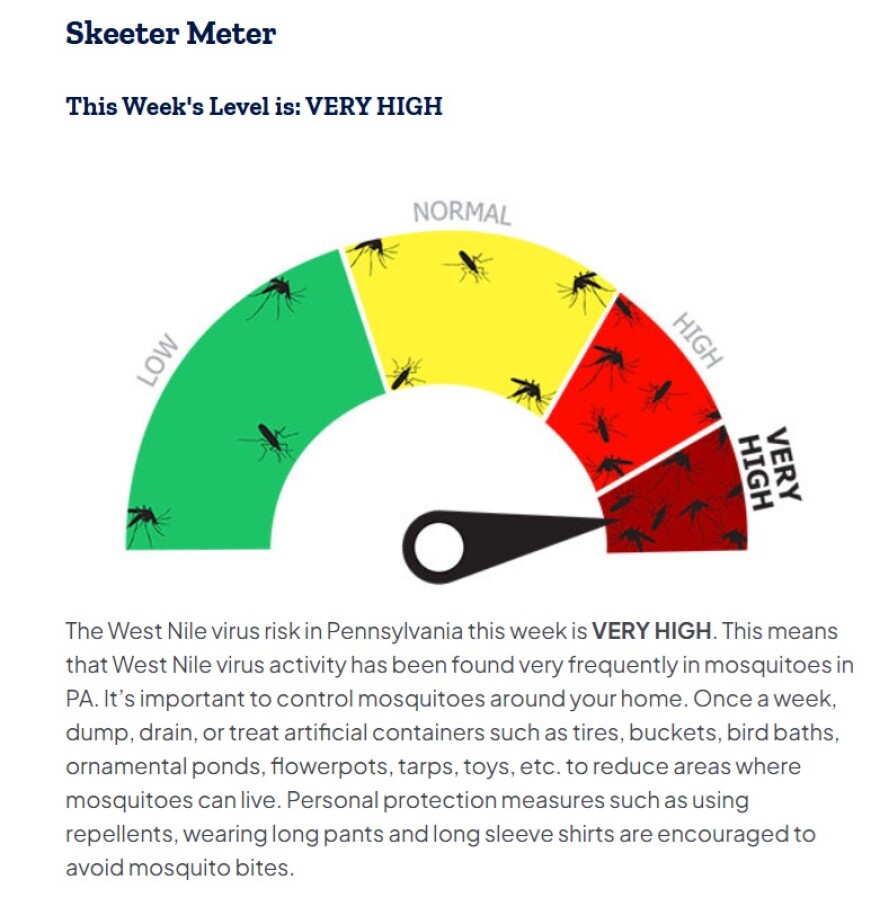BETHLEHEM, Pa. — It’s peak mosquito season in the Lehigh Valley, and that means it's West Nile virus season, too.
“This year is not a super high year for West Nile, but it is still here," said Jessica Koch, vector borne disease control coordinator for the Lehigh County Conservation District.
“It’s here every year around this time and it’s important that people are trying to avoid those mosquito bites.”
So far this season, there have been nine human cases of West Nile virus in Pennsylvania: three in Lancaster County, and one each in Allegheny, Bucks, Fayette, Lawrence, Philadelphia and Schuylkill counties, according to data from the state Department of Environmental Protection.

Asked about the status of human cases, a state Department of Health spokesperson said, “To protect patient confidentiality, the department does not provide information on the health conditions of patients.”
‘West Nile virus is everywhere’
Chrysan Cronin, director and associate professor emerita of public health at Muhlenberg College, remembers when West Nile virus began impacting birds in the early 2000s.
The virus was first recognized in 1999 in New York City.
Dead birds can act as a harbinger, foreshadowing the presence of West Nile virus, she said.
Mosquitoes feeding off infected birds pick up the virus and can then transmit it by biting mammals, including people.
“It was a new virus for us — we didn't have it before then,” Cronin said. “And, subsequently, it has become endemic.”
Now, West Nile virus is an annual presence, just at low levels.
“When a disease becomes endemic, you do see this low level kind of plateau, like epidemic curve, where it's just always there, but it's not really exacerbating,” Cronin said.
“It's not getting worse, but there are variables that could affect that.”
Each year, officials in each county across the commonwealth trap and test mosquitoes for West Nile virus.
The state DEP updates its website each week with county reports of positive West Nile virus cases in mosquitos and humans. As of Friday, there were 77 mosquito positives in Lehigh County, 31 in Northampton County.
Koch said monitoring, which begins in May, runs through the end of September.
“We set mosquito traps at certain locations around Lehigh County, then we’ll pick them up and send them off to the DEP lab in Harrisburg,” she said. “They’re counted, identified and tested.”

This year has been “more of a nuisance mosquito year,” due to constant patterns of rain, she said.
“We’re a little bit behind with the West Nile virus activity this year,” Koch said. “We are behind, but, in general, West Nile doesn’t seem to be as high as usual, or at least compared to last year.”
Last year, there were three cases of West Nile virus in humans in Lehigh County; there were none in Northampton County, according to state data. The most recent death from West Nile virus in the Valley was in 2023, in Lehigh County.
There are more than 60 species of mosquitoes in the commonwealth, but only culex mosquitoes carry West Nile.
“The floodwater mosquitoes tend to be more aggressive biters than the culex mosquitoes,” Koch said.
“Once there’s a lot of flood water species, or those nuisance mosquitoes, you tend to get more complaints because they’re more aggressive.”
As recently as last summer, officials have used truck-mounted spray operations to tamp down on West Nile-carrying mosquitoes. However, there haven’t been any in Lehigh County so far this year.
“We don’t want to scare people into thinking they’re safe in certain areas and not in others because West Nile virus is everywhere.”Jessica Koch, vector borne disease control coordinator out of the Lehigh County Conservation District
There have been localized control events when certain thresholds have been met, Koch said.
“Typically, we don’t like to tell people the number of mosquitos in a certain area, because then they’ll start avoiding areas,” Koch said.
“We don’t want to scare people into thinking they’re safe in certain areas and not in others because West Nile virus is everywhere.”
Longer summers, longer mosquito seasons
In Pennsylvania, West Nile virus can be found in mosquitoes during the summer and fall months, peaking in August and September.
However, climate change could be stretching the season out — not just in Pennsylvania, but across the continent.
“It's really a growing threat that we're starting to hear about more and more, and you might even be noticing it in your everyday life, as you see more and more mosquitoes over longer periods of the year.Erin Mordecai, an associate biology professor at Stanford University
“Because of increases in temperature that we've already seen, because of human impacts on the climate, the temperature is already getting more suitable for transmission of disease here in the United States and North America,” Erin Mordecai, an associate biology professor at Stanford University, said during a recent SciLine event.
“And we're already starting to see increases in transmission of diseases like West Nile, Lyme disease, maybe, even to some extent, dengue and malaria. So, it's really a growing threat that we're starting to hear about more and more, and you might even be noticing it in your everyday life, as you see more and more mosquitoes over longer periods of the year.
“So, it's not just the summer anymore.”
Her research has shown the season for West Nile virus transmission in New York has increased by 25 days over the last 25 years.
"That's because it's getting warm earlier in the year and it's staying warm later in the year in New York, and that translates directly into greater infection prevalence in the mosquitoes that transmit West Nile and larger numbers of cases in humans in New York,” Mordecai said.
“So, we're already seeing climate change increasing the amount of West Nile transmission we have in New York.”
Similarly, the Lehigh Valley has also seen the shoulder season stretch — it’s getting warmer earlier in the year, and staying that way well into the fall.
“Because we have many more months of warm weather than we used to, it is really helping mosquitoes have a longer reproductive season,” Cronin said.
“We're starting to see them in early April — they go through October, sometimes even into November, depending on our weather patterns.”
‘You would never even know it’
The majority of those infected with West Nile virus don’t even know they have it, Cronin said.
“Even if [a mosquito] does bite you, and you do get infected with the virus, at least 80% of the time you're asymptomatic and you would never even know it, and it clears itself from your body and you're fine."Chrysan Cronin, director and associate professor emerita of public health at Muhlenberg College
“Even if [a mosquito] does bite you, and you do get infected with the virus, at least 80% of the time you're asymptomatic and you would never even know it, and it clears itself from your body and you're fine,” Cronin said.
“So only 20% of the time, if you are affected, would you even show any kind of symptoms, and usually, if you do, they're very, very mild, very nondescript — fever, fatigue. Sometimes there's a rash associated with it, sometimes not, and then you recover on your own.
“And then there's that very, very minuscule chance, that 1% chance, that you might actually progress to something much more severe, like something neurological, like encephalitis, and die from it.”
While there is no specific treatment for West Nile, rest, fluids and pain medications may relieve less serious symptoms, according to the Centers for Disease Control and Prevention.
So far this year, there have been 219 human cases of West Nile virus reported across the United States.
However, because the vast majority are asymptomatic, numbers are probably under-reported, Cronin noted.
“We really have no idea how many people are infected,” she said. “We don't have any idea what the prevalence of this disease is in humans, because we don't all get tested.”

Residents can protect themselves from mosquito bites by wearing clothing that covers the skin, especially during dawn and dusk, when West Nile-carrying mosquitoes are most prevalent, Cronin said.
They can also clear any standing water from around their properties or near their homes.
“Mosquitoes can live in a tablespoon of water,” Cronin said. “So, you really want to be careful to make sure your property is cleared, make sure your screens are in your windows, keep your door shut if you have air conditioning — do the best you can to avoid getting mosquito bites.”


